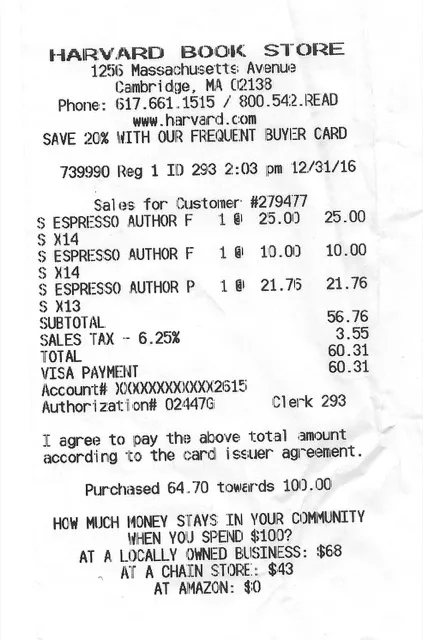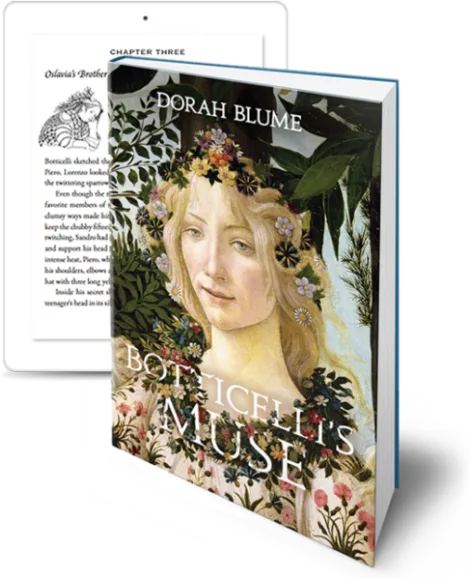Dorah Blume at the Isabella Stewart Gardner Museum on a staircase that inspired a scene in her new historical novel – photo by Rob MacIntosh
Back at the start of the year, American indie author Dorah Blume came up with an interesting and unusual way to bolster her confidence and advance her progress with her debut novel: the use of a Xerox Espresso Book Machine (TM to produce automatically and instantly a bound, printed book of her work in progress.
The fact that her historical novel, Botticelli's Muse, is poised to launch this week demonstrates that this technique worked for her, and, if you're lucky enough to live near an Espresso Book Machine (TM), you might like to try it too! Over to Dorah to tell us exactly what she did, and why…
When Self-publishing a Book is Like Birthing a Baby…
Having a printed copy of my debut novel in hand was living proof that I was birthing a real book.
When I was pregnant with my first child all those years ago, I often joked that I had no proof I was gestating a human. (This was before ultrasound.) I could be giving birth to a puppy or some cryptid – an imaginary creature, half-human, half deity/devil, like in Rosemary’s Baby, or a demi-god like in Rick Riordan’s Percy Jackson series.
Bringing my debut historical novel Botticelli’s Muse into a book form was a lot like that first pregnancy.
All my work on the book over the years had been flat, and two-dimensional. Words on a page. Revisions and rewrites. Drawings, too. Everything had been about growing a novel until December 31, because I’d vowed I’d publish it before the end of 2016.
And When It's Not…
But there hangs the difference between birthing a baby and birthing a book. Go over your due date, and your labour will be induced. You can’t keep putting off the date of birth, just because you’ve realised the process takes longer than you’d expected.
Getting a book published, and I want to say responsibly published, has its own timeline.
I’d begun to understand why two years often elapse between big publishing deals and the release of a book.
But it was New Year’s Eve day. Earlier in 2016 I had said out loud that if I didn’t have my book published in 2016, I would go into a serious depression.
My Espresso Book Machine Solution
As 2016 was coming to a close, on the last Saturday afternoon, December 31, I was planning to meet a friend in Harvard Square, Cambridge, the same city where I had learned six months earlier that Harvard Book Store housed an Espresso Book Machine, I decided to throw the file for the cover design and the latest un-proofread pdf file from the typesetter onto a thumb drive, just in case.
My friend Mary left me out front of the bookstore at 2.15pm. I went inside, showed the files to Annie, the Expresso POD operator, who told me that my sample books would be ready that day. Twenty-five dollars for the set-up, another $10 to give the e-book cover a spine and back, and $21 to print a second copy. (They offer the first book as a free proof.)

Preserved for posterity: the Espresso Book Machine receipt
An hour later, I was elated to hold my not-quite-ready-to-print BOOK – my 500+ page novel, complete with all its tiny spot illustrations – in my hands.
Finally, three dimensions! I could feel its weight, flip through the pages, see finally, how thick the spine was going to be.
Even though it was a proof, even though I hadn’t priced it or had it professionally proofread, I could see, finally, that I was, and have been gestating a BOOK. Squeals of delight were in order, even inside the bookstore.

“Congratulations on the safe delivery of your beautiful, healthy baby!”
Spurred on Finish the Self-Publishing Process
Seeing my “artist proof” copies (I decided to get two books) reminded me of coins minted with the wrong date or image that over time become prized collector items. Maybe this first proof book, complete with flaws, might fall into that category?
At the same time, holding my novel in my hands as a real book as delivered serious blows to the head-harpies and gremlins who had traveled with me through the journey, incessantly yapping such things as, “You’re a hack!” “Who do you think you are?” “Does the world need another book?”
A few days later, the glow of excitement to see all my hard work in book form began to fade as I confronted what was left to do: put in proofreader’s changes to the ebook and typeset file, decide on a POD printer, and/or offset lots of copies. Plenty of questions remained:
- Do I use Ingram Spark, Book Baby, bookprinters.com, CreateSpace?
- Do I upload the e-book myself to book sellers or use Smashwords?
- Hire a publicist? A virtual assistant?
- When will my author’s website be ready and what else should I be doing with my author’s Facebook page?
- How soon do I offer preorder or do I just wait until everything’s ready to go?
More research was in order, more delayed gratification. But the book as an object had made its entrance into the material world and I knew I’m getting closer.
Hopefully, this first book birth would pave the way for an easier delivery for its sequel.
OVER TO YOU If you've ever used an Espresso Book Machine (TM), we'd love to hear about how it worked for you – what would be your top tips to other indie authors on the experience? Have you found other innovative ways to move yourself along the author journey? We'd love to know!
#Authors - here's a fun case study of using an #EspressoBookMachine @walkinghead2009 Share on XOTHER WAYS TO EASE ANXIETY ON THE INDIE AUTHOR JOURNEY





Awesome! Good questions to be asking yourself, too, which I appreciate you sharing with us, along with your story. Best of luck in continuing your journey!